2. 中国地质大学地质过程与矿产资源国家重点实验室, 北京 100083
2. State Key Laboratory of Geological Processes and Mineral Resources, China University of Geosciences, Beijing 100083, China
秦岭造山带是我国中央造山带的重要组成部分,经历了新太古代-古元古代的基底形成、新元古代-古生代的构造演化阶段及中生代以来的陆内造山3个重要的演化阶段,是典型的复合型大陆造山带 (张国伟, 1991; 张国伟等, 2001)。西秦岭属于秦岭造山带的西延,夹持于青藏高原东北缘、扬子西北缘、南祁连和东昆仑多个块体之间 (张国伟等, 2004),它是秦祁昆成矿域西秦岭成矿带的重要组成部分,也是青海省重要的有色及贵金属基地。对于西秦岭的演化历史,尤其是印支期由洋壳俯冲至陆陆碰撞以及后来的后造山伸展阶段尚存在较大的争议 (张宏飞等, 1999; Meng and Zhang, 2000; 张国伟等, 2001; Sun et al., 2002; Zhang et al., 2008; Qin et al., 2010a, b; Jiang et al., 2010; Cao et al., 2011; Dong et al., 2011; Zhu et al., 2011; Guo et al., 2012; Yan et al., 2014; Li et al., 2014b, 2015)。
双朋西矽卡岩型金铜矿床位于位于青海省同仁县东部,是西秦岭成矿区一个十分重要的代表性矿床 (傅晓明等, 2010)。与成矿有关的花岗闪长岩体是研究区岗察复式岩体的一部分。前人对该矿床地质特征 (息朝庄, 2009; 薛静等, 2012),控矿条件 (路英川等, 2016) 成矿流体来源 (傅晓明等, 2010) 等进行了研究,但对与成矿有关岩浆岩的岩石学、地球化学和年代学研究尚较薄弱。本文针对双朋西矿区与金铜成矿有关的中细粒花岗闪长岩,开展了岩石地质地球化学、成岩年代学和成因研究,以阐明岩浆来源和形成过程,为西秦岭地区印支早期的地球动力学背景提供重要信息。
1 区域地质双朋西金铜矿床位于西秦岭印支期构造岩浆带西段 (图 1a),是岗察复式岩体南侧一典型的矽卡岩型矿床。区域出露地层为二叠系大关山群甘家组、三叠系隆务河群、第三系和第四系组成的盖层。甘家组主要分布在矿区及其北部,为一套浅海相碎屑岩、碳酸盐岩建造,主要岩性为灰白色中粗粒厚层大理岩、灰黑色细砂岩夹薄层大理岩透镜体,其中粗粒大理岩分布广泛,出露厚度大于100m,呈灰白色,块状构造,粗粒变晶结构。该地层多沿构造接触带分布,矽卡岩化较发育,局部夹杂黑色细砂岩;三叠系隆务河群主要分布在矿区南部,与二叠系甘家组呈断层接触,为一套海相复理石建造,岩性主要以互层状产出的灰绿-紫红色长石石英砂岩和灰黄色的石英砂岩为主,其中夹杂有薄层状粉砂岩及薄层状灰岩。
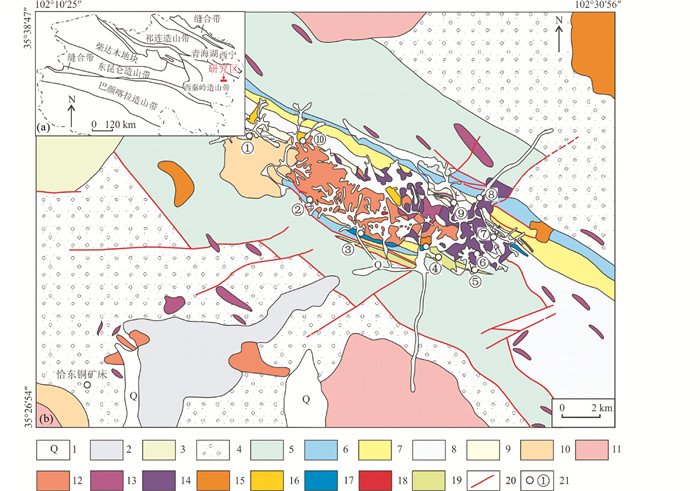
|
图 1 西秦岭双朋西金铜矿床区域地质略图 (a, 据王小丹等, 2010; b, 据路英川等, 2016, 略有修改) 1-第四系;2-新近系砾岩;3-白垩系下统砾岩;4-三叠系隆务河群含砾砂岩;5-三叠系隆务河群石英砂岩;6-二叠系甘家组钙质砂岩;7-二叠系甘家组粉砂岩;8-二叠系甘家组大理岩;9-二叠系甘家组泥质粉砂岩;10-斑状花岗岩 (πγ5);11-斑状花岗闪长岩 (πγδ5);12-花岗闪长岩 (γδ5);13-闪长玢岩 (δμ);14-辉石闪长岩 (δi5);15-闪长岩 (δ5);16-石英闪长岩 (δο5);17-花岗岩脉 (γ);18-破碎带;19-矽卡岩;20-断层;21-矿床 (点):①-江里沟钼矿点;②-双朋西金矿床;③-铁吾铜金矿点;④-德合龙洼金铜矿;⑤-红旗卡铜金矿点;⑥-红旗卡铜矿点;⑦-斜长支沟铜矿点;⑧-谢坑铜金矿床;⑨-岗察铁矿床;⑩-郎木加铜矿点 Fig. 1 Regional geological sketch of Shuangpengxi gold copper depositin western Qinling (a, after Zhang et al., 2007; Wang et al., 2010; b, after Lu et al., 2016, revision) 1-Quaternary; 2-Neogene conglomerate; 3-Lower Cretaceous conglomerate; 4-Triassic Longwuhe Group conglomeratic sandstone; 5-Triassic Longwuhe Group quartz sandstone; 6-Permian Ganjia Group calcareous sandstone; 7-Permian Ganjia Formation siltstone; 8-Permian Ganjia Formation marble; 9-Permian Ganjia Formation argillaceous siltstone; 10-porphyritic granite (πγ5); 11-porphyritic granite diorite (πγδ5); 12-granite diorite (γδ5); 13-diorite porphyrite (δμ); 14-augite diorite (δi5); 15-diorite (δ5); 16-quartz diorite (δο5); 17-granite dike (γ); 18-fracture zone; 19-skarn; 20-fault; 21-ore deposits (points): ①-Jiangligou molybdenum ore; ②-Shuangpengxi gold-copper deposit; ③-Tiewu copper-gold ore; ④-Dehelongwa gold-copper deposit; ⑤-Hongqika copper-gold ore; ⑥-Hongqika copper ore; ⑦-Xiechangzhigou copper ore; ⑧-Xiekeng copper-gold deposit; ⑨-Gangcha iron ore deposit; ⑩-Langmujia copper ore |
区域褶皱有岗察棍巴-恰琼根复式背斜,其轴线长大于2km,枢纽波状起伏,呈北西-南东向展布。从构造形迹上看,双朋西背斜是矿区的主体构造,分布在矿区中部,背斜轴线为NW-SE向展布,轴线长大于2km,宽300~500m,枢纽有波状起伏现象。由于岩浆活动的破坏使背斜北翼不全,但南翼保存较完整。南翼地层倾角较缓,为23°~30°;北翼地层倾角35°~45°。区域上发育北西向断裂,其为主要的控矿断裂构造;其次发育北东向断裂。
区内侵入岩体分布广泛,代表性的岩体为印支-燕山期闪长岩和花岗闪长岩。印支期中酸性岩浆侵入活动强烈,以岗察复式岩体为代表,出露面积达22km2。从东到西,岗察岩体的岩性有由中基性向中酸性演化的趋势 (闪长岩→花岗闪长岩→二长花岗岩及斑状花岗岩,图 1b)(陶志华等, 2014)。
2岩体地质及岩相学分布于双朋西金铜矿区北部的花岗闪长岩岩体,呈岩株状产出,出露面积约16km2。它是区域岗察复式岩体组成的一部分 (图 1、图 2)。矿区花岗闪长岩岩体总体上呈NW向展布,其与围岩甘家组地层中的大理岩接触带部位常形成NW向的矽卡岩带。由于构造作用的破坏,常在岩体内部形成密集的微裂隙带,使岩体与围岩接触带呈波状分布 (图 2b)。
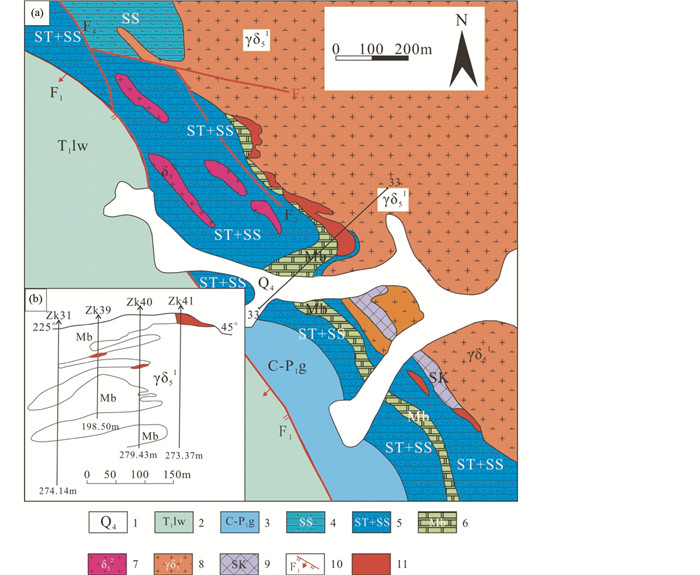
|
图 2 双朋西金铜矿区地质图和33勘探线剖面图 (据张涛, 2007, 略有修改) 1-第四系;2-下三叠统隆务河群;3-石炭-中二叠统大关山群;4-钙质砂岩;5-石英砂岩;6-大理岩;7-花岗岩;8-花岗闪长岩;9-矽卡岩;10-断裂;11-矿体 Fig. 2 Geological and 33 prospecting line profile map of Shuangpengxi gold copper deposit area (modified after Zhang, 2007) 1-Quaternay; 2-Lower Triassic Longwuhe Group; 3-Carboniferous-Lower Permian Daguanshan Group; 4-calcareous sandstone; 5-quartz sandstone; 6-marble; 7-granite; 8-granodiorite; 9-skran; 10-fault; 11-ore body |
花岗闪长岩呈灰-灰白色 (图 3a, b),全晶质结构、中细粒花岗结构或似斑状结构 (图 3c),块状构造 (图 3b),主要矿物为斜长石 (30%~35%)、石英 (约20%~25%)、角闪石 (20%~30%) 和黑云母 (约15%),次要矿物为钾长石 (约10%),副矿物有锆石和磷灰石等。其中斑晶主要为斜长石与角闪石,基主要由为石英和黑云母构成 (图 3c)。斜长石常呈柱状或板柱状结构,颗粒大小约0.5~3.2mm,常见聚片双晶,有时可见环带及韵律环带结构。钾长石呈短柱状或板状,半自形晶结构,常见卡氏双晶。角闪石则呈柱状结构或粒状结构,半自形晶或他形晶,少量角闪石中间发生部分溶蚀现象 (图 3d),但极少数形成交代穿孔结构,最常见的穿孔矿物为黑云母。黑云母常呈褐色或褐黄色,鳞片状结构,部分晶粒边缘被溶蚀成锯齿状。含有少量的金属矿化,主要为黄铜矿,磁黄铁矿,黄铁矿和闪锌矿等 (图 3e, f),呈微细浸染状 (图 3b)。有少量黄铁矿、磁黄铁矿在造岩矿物内部或边部生长,或充填于造岩矿物解理中。根据矿物结构和相互关系判断生存顺序为:角闪石和斜长石→石英→黑云母→黄铜矿、磁黄铁矿、黄铁矿和闪锌矿。
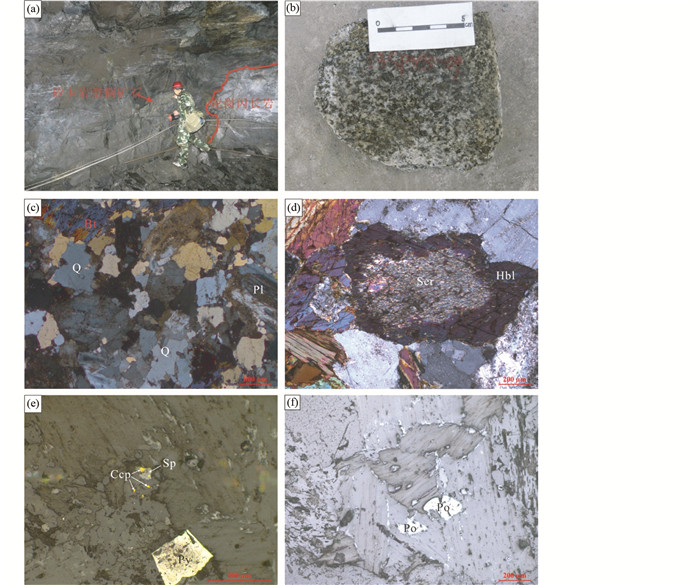
|
图 3 花岗闪长岩产出特征及显微镜下照片 (a) 花岗闪长岩与矽卡岩型矿石接触关系;(b) 中粒花岗闪长岩;(c) 花岗闪长岩显微照片 (正交偏光);(d) 角闪石内部绢云母化 (正交偏光);(e) 花岗闪长岩中金属矿化 (单偏光);(f) 矽卡岩矿石矿物组合 (单偏光). Bt-黑云母;Ccp-黄铜矿;Hbl-普通角闪石;Pl-斜长石;Po-磁黄铁矿;Py-黄铁矿;Qtz-石英;Sp-闪锌矿 Fig. 3 Photos and micrographs of the granodiorite (a) contact relation of granodiorite and skarn ore body; (b) medium-coarse grained granodiore; (c) micrograph of granodiorite (cross-polarized light); (d) internal sericitization of amphibole (cross-polarized light); (e, f) metallized granodiorite (single polar). Bt-biotite; Ccp-chalcopytite; Hbl-hornblende; Pl-plagioclase; Po-pyrrhotite; Py-pyrite; Qtz-quartz; Sp-sphalerite |
首先将野外采集的花岗闪长岩新鲜样品 (编号13SPX-07) 约2kg,送至河北廊坊市峰泽源岩矿检测技术有限公司进行锆石挑选;然后在北京锆年领航科技有限公司进行锆石制靶,并在扫描电镜加载阴极发光仪上完成锆石阴极发光 (CL) 显微照相工作;最后在中国科学技术大学壳幔物质与环境重点重点实验室的LA-ICP-MS仪器上进行锆石原位U-Pb同位素定年分析。分析仪器为Elan DRC Ⅱ型四极杆质谱仪和GeoLas Pro 193μm型激光剥蚀系统,激光器为193nm ArF准分子激光器。锆石年龄计算采用标准锆石91500作为外标,TEM作为内标,29Si作为内标元素进行校正。测试结果通过LaDating@Zrn.xls ver 1.0软件计算获得,并按照Andersen (2002)的Com Pb Con# 32151程序对其进行了普通铅校正。校正后的数据使用美国Berkeley地质年代学中心编制的ISOPLOT和SQUID (Ludwig, 2003) 程序进行处理并得出年龄。
3.2 分析结果双朋西花岗闪长岩样品的锆石 (图 4),颗粒长100~300μm,宽40~150μm,形态为长柱状或短柱状,在透射显微镜下均呈无色或浅黄色,透明或半透明。锆石CL图像显示,其晶体自形程度较高,多具有核幔构造,核部呈自形、半自形,个别具浑圆状溶蚀边,内部发育带状和震荡环带;幔部一般发育震荡环带。所测定的29颗锆石Th/U比值 (0.68~1.36) 均大于0.4(表 1),且Th、U含量呈较好的正相关性。由此说明,其属岩浆成因的锆石 (Rubatto and Gebauer, 2000; Rubatto, 2002; Belousova et al., 2002; Möller et al., 2003)。
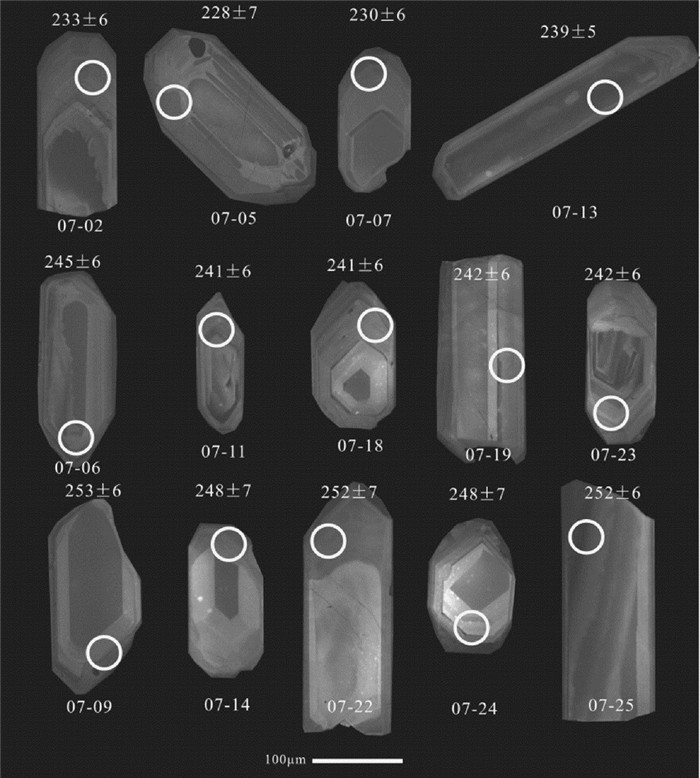
|
图 4 青海双朋西花岗闪长中锆石特征和LA-ICP MS测点位置 Fig. 4 Zircon cathodoluminescence (CL) images and analysis spots from the Shuangpengxi granodiorite |
|
|
表 1 青海省双朋西花岗闪长岩体中锆石LA-ICP-MS U-Th-Pb同位素定年结果 Table 1 LA-ICP-MS U-Th-Pb isotope dating results of zircon of the Shuangpengxi granodiorite pluton, Qinghai |
获得锆石的206Pb/238U年龄值为253~228Ma (表 1),单个数据的测试误差 (1σ) 为6~8Ma,年龄变化相差25Ma超过了单颗锆石年龄的误差范围。从表 1中的测试数据可以看出,其存在3个年龄群,分别集中在249Ma、241Ma和234Ma。已有研究成果表明,具有不同不同的振荡环带特征的锆石可能来自不同的晶体群,反映了岩浆演化过程中不同阶段物理化学状态的不同,因而具有不同年代学的意义 (罗照华等, 2013)。本文获得的聚集在249~241Ma左右的锆石,其CL图相中的核-边显示出不同的振荡环带特征:核部呈灰白色或亮白色,振荡环带较宽;边部呈暗灰色,振荡环带较窄而密。这些特征类似于循环晶锆石的特点 (Jerram and Martin, 2008),是岩浆系统早期处于高温下结晶而成的 (Wu and Zheng, 2004)。但聚集在234Ma的锆石多为呈长柱状,其CL图像为灰黑色,振荡环带分布均匀,锆石中Th和U含量分别为45.4×10-6~122.9×10-6和63.7×10-6~132.4×10-6,反映锆石是在岩浆系统稳定状态下逐渐结晶而成的。因此,将29颗锆石年龄进一步细分后,再分别进行加权平均年龄计算,获得的年龄分别是250.6±4.7Ma (MSWD=0.09,n=7)、242.3±4.2Ma (MSWD=0.05,n=7) 和233.9±2.8Ma (MSWD=0.51,n=15)(图 5)。每个组的测点数据均落于谐和线上或其附近,显示很好的谐和性 (协和度>95%),表明锆石形成后U-Pb同位素体系是基本封闭的,没有U或Pb同位素的明显丢失或加入。其中,最小年龄值233.9Ma,代表了岩浆最后固结的年龄。
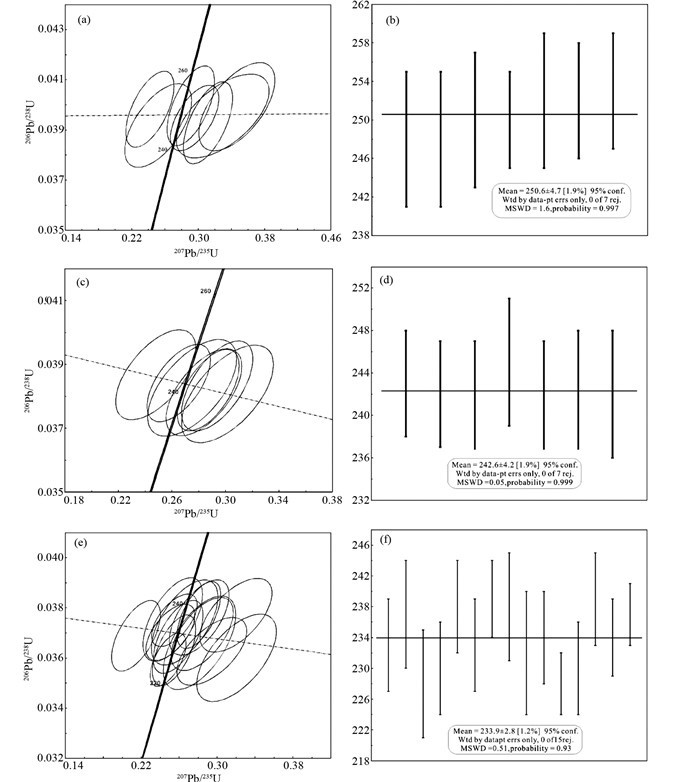
|
图 5 双朋西铜金矿床花岗闪长岩锆石U-Pb年龄谐和图 (a、c、e) 和加权平均图 (b、d、f) Fig. 5 Concordia (a, c, e) and weighted average (b, d, f) diagrams of zircon grains from granodiorite in the Shuangpengxi gold-copper deposit |
本文对双朋西花岗闪长岩 (共8件) 进行了岩石地球化学分析。挑选新鲜样品经破碎处理后,在核工业北京地质研究院进行岩石的主量、微量及稀土元素的分析测试。主量元素分析采用AB-104L,PW2404 X射线荧光光谱仪。分析流程为:首先将样品按1:5的比例放入Li2B4O7溶液中,并在1050~1250℃温度下熔化,然后将熔化样品制成玻璃薄片进行分析,分析精度优于1%。微量元素和稀土元素的分析采用ELEMENT XR等离子体质谱分析仪 (编号:9443)。其分析流程为:将50mg、200目的全岩粉末样置于Teflon烧瓶中,分别用HNO3和HF溶解2d后加入HClO4进一步溶解;蒸干后用5%的HNO3溶液将样品稀释到50mL;最后进行微量、稀土元素的测试。在分析过程中同时对GBW系列标样进行测定,以检验其外部重现性,分析误差 < 2%。
全岩Sr-Nd同位素在核工业北京地质研究院分析测试研究中心进行分离,利用ISOPROBE-T热电离质谱计进行测定,采用86Sr/88Sr=0.1194和146Nd/144Nd=0.7219标样进行质量分馏校正,标准测量结果:NBS987为0.710250±7,JMC为143Nd/144Nd=0.512109±3,Sr和Nd空白值分别小于2ng和50pg;全岩Pb同位素的分离提纯及测定也均在核工业北京地质研究院分析测试研究中心完成,同位素分析采用ISOPROBE-T热电离质谱计进行测定,NBS981未校正结果:208Pb/206Pb=2.164940±15,207Pb/206Pb=0.914338±7,204Pb/206Pb=0.0591107±2,全流程本底Pb < 100pg。
4.2 主量元素特征双朋西花岗闪长岩主量元素分析结果见表 2。8件花岗闪长岩样品的主量元素含量分别为:SiO2 62.89%~70.37%(平均65.26%),(K2O+Na2O)6.04%~7.25%(平均6.42%),Na2O 2.24%~2.94%(平均2.65%)。结合前人的分析测试数据,在全碱-硅分类图解中 (图 6a),投点落于花岗闪长岩 (或与闪长岩或花岗岩交界) 的区域,这与显微镜下鉴定的岩相学特征一致;花岗闪长岩Al2O3含量12.54%~15.71%(平均14.83%),铝饱和指数 (A/CNK) 为0.84~1.03,大部分投点落于准铝质和过铝质花岗岩的交界处,但有三个位于准铝质范围,具有I型花岗岩特征 (图 6b)。花岗闪长岩K2O含量3.35%~5.01%(平均3.77%),MgO含量1.17%~2.62%(平均2.13%) 及Mg#值 (31.6~35.2)。在K2O-SiO2图解中,主要属于高钾钙碱性系列 (图 6c),另外有两个点分别落入钾玄岩系列和高钾钙碱性系列的交界处。
|
|
表 2 双朋西花岗闪长岩主量元素 (wt%)、稀土和微量元素 (×10-6) 分析结果 Table 2 Major element (wt%), trace elements (×10-6) of granodiorite in the Shuangpengxi gold-copper deposit |
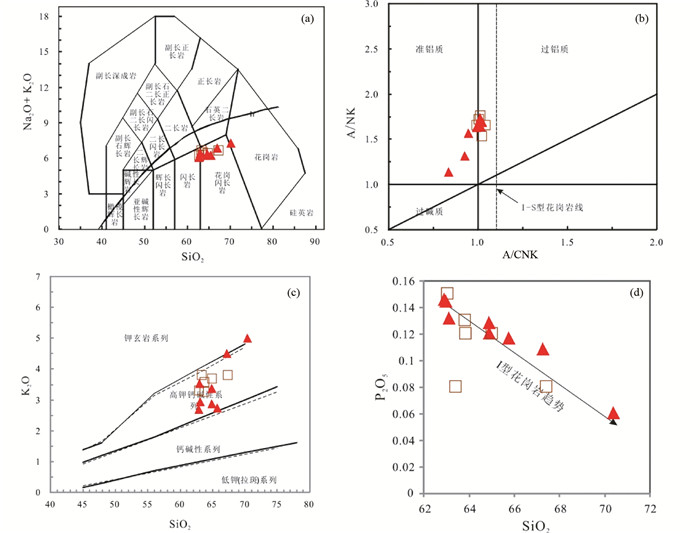
|
图 6 双朋西花岗闪长岩TAS (a, 据Middlemost, 1994)、A/NK-A/CNK (b, 据Shand, 1943)、K2O-SiO2(c, 实线据Peccerillo, 1976; 虚线据Middlemost, 1985) 和P2O5-SiO2(d) 关系图 正方形为本文数据; 三角形据Luo et al., 2012; 张涛, 2007; 息朝庄, 2009;图 10、图 11同此图 Fig. 6 TAS (a, after Middlemost, 1994), A/NK vs. A/CNK (b, after Shand, 1943), K2O vs. SiO2 (c, real line after Peccerillo et al., 1976; broken line after Middlemost et al., 1985) and P2O5-SiO2 (d) diagrams of granodiorite in the Shuangpengxi gold-copper deposit Square from this study; Triangle from Luo et al., 2012; Zhang, 2007; Xi, 2009; also in Fig. 10 and Fig. 11 |
双朋西花岗闪长岩CIPW标准矿物显示,样品A/CNK < 1.1,CIPW标准矿物计算主要矿物为石英 (17.55%~30.42%)、钙长石 (9.46%~20.48%)、钠长石 (19.14%~24.50%)、正长石 (19.40%~29.90%),次要矿物为透辉石 (0.86%~4.10%)、紫苏辉石 (3.57%~11.89%)、磁铁矿 (2.72%~5.18%)、钛铁矿 (0.56%~1.25%) 和磷灰石 (0.14%~0.33%),不含刚玉,显示出准铝质的I型花岗岩系列特征 (韩吟文和马振东, 2003)。双朋西金铜矿花岗闪长岩的P2O5含量随SiO2的增加而降低 (图 6d),也暗示为I型花岗岩 (Wolf et al., 1994; 于玉帅等, 2011)。
4.3 微量元素双朋西铜矿8件花岗闪长岩样品稀土和微量元素分析结果 (表 2) 显示,稀土元素含量为ΣREE=143.2×10-6~506.8×10-6(平均229.9×10-6),高于地壳岩浆岩平均值 (164×10-6)。稀土元素配分呈右倾模式 (图 7a, (La/Yb)N=5.68~28.5),富集轻稀土元素 ((La/Sm)N=3.14~11.6),重稀土元素分布较平滑 ((Gd/Yb)N=1.17~1.63)。8件样品具有中等的Eu负异常,δEu=0.35~0.78,可能说明岩石存在一定的斜长石分异作用或岩浆起源于斜长石稳定区。

|
图 7 双朋西金铜矿床花岗闪长岩球粒陨石标准化稀土元素分配曲线 (a,阴影部分数据引自Luo et al., 2012; 息朝庄, 2009) 与原始地幔标准化微量元素蜘蛛网图 (b,灰点样品数据引自Luo et al., 2012) Fig. 7 Chondrite-normalized REE distribution patterns (a, data of shadow from Luo et al., 2012; Xi, 2009) and primitive mantle-normalized trace element spider diagram (b, data of grey samples from Luo et al., 2012) of granodiorite in the Shuangpengxi gold-copper deposit |
花岗闪长岩Rb、K、Th、U等大离子亲石元素富集,Ta、Ti、Hf、P等高场强元素亏损 (图 7b)。Ba、Sr的负异常特点,反映了在部分熔融过程中源区有碱性长石、斜长石残留或在岩浆演化过程中有碱性长石、斜长石结晶分异;而P、Ti、Nb的负异常则与磷灰石、Fe-Ti氧化物残留或分异有关;Ta、Nb的负异常暗示源区可能有榍石、金红石等矿物的残留 (Green and Pearson, 1986)。
4.4 Sr-Nd-Pb同位素本文对双朋西花岗闪长岩 (共4件) 进行了Sr-Nd-Pb同位素分析 (表 3)。所有样品Sr初始值Isr和εNd(t) 值的计算所采用的年龄为t=233.9Ma。计算表明,双朋西花岗闪长岩具有较高的 (87Sr/86Sr)i初始值 (0.708299~0.708748),较低的 (143Nd/144Nd)i初始值 (0.51168~0.51185) 和负的εNd(t) 值 (-12.6~-9.47)。双朋西花岗闪长岩的 (87Sr/86Sr)i组成与同仁地区花岗闪长岩相似 ((87Sr/86Sr)i=0.707616~0.708237, Li et al., 2015)。Pb同位素206Pb/204Pb、207Pb/204Pb和208Pb/204Pb比值分别是18.623~18.965、15.610~15.652和39.124~40.732,具有较高的相似性。
|
|
表 3 双朋西花岗闪长岩Sr-Nd-Pb同位素组成 Table 3 Sr-Nd-Pb isotopic compositions of granodiorite from the Shuangpengxi gold-copper deposit |
近年来,在区域岗察复式岩体与石炭-中二叠统大关山群灰岩接触带部位发现了江里沟铜钼矿床、谢坑铜金矿床、斜长支沟铜矿床、郎木加铜矿床、红旗卡金铜矿床、德合隆洼金铜矿床、铁吾铁金铜矿床等多个矽卡岩型矿床 (图 1b)。矽卡岩型矿床成矿时代大致与岩体侵位时代相同 (Watanabe et al., 1988; Annikova et al., 2006)。众多研究结果显示,岗察岩体周边的铜、金、钨、钼、铁矿床成矿与岩浆活动关系密切,成矿流体、成矿物质主要来源于岩浆,成矿作用与岩浆活动发生的时间一致 (张涛等, 2014)。
对于该地区的岩浆活动发生的时间,前人获得了大量数据。如Li et al. (2015)获得同仁地区花岗闪长岩U-Pb年龄为241±2Ma;Guo et al. (2012)获得岗察岩体中辉长闪长岩和矿化闪长岩锆石U-Pb年龄分别为243.8±1.0Ma和234±0.6Ma。西秦岭地区其它岩体形成时间也与此类似。如夏河花岗闪长岩 (244~248Ma, 韦萍等, 2013; 238±4Ma, 金维浚等, 2005)、黑马河花岗闪长岩 (235±2Ma, 张宏飞等, 2006)、卡而却卡花岗岩 (237±2Ma, 王松等, 2009)、虎头崖花岗闪长岩 (235.4±1.8Ma, 丰成友等, 2011) 和谢坑辉石闪长岩 243.8±1.0Ma, (郭现轻等, 2011; 238±3Ma, 张涛等, 2014)。因此,岩浆岩年代学数据显示,西秦岭地区在早-中印支期曾广泛发育了一次岩浆活动。
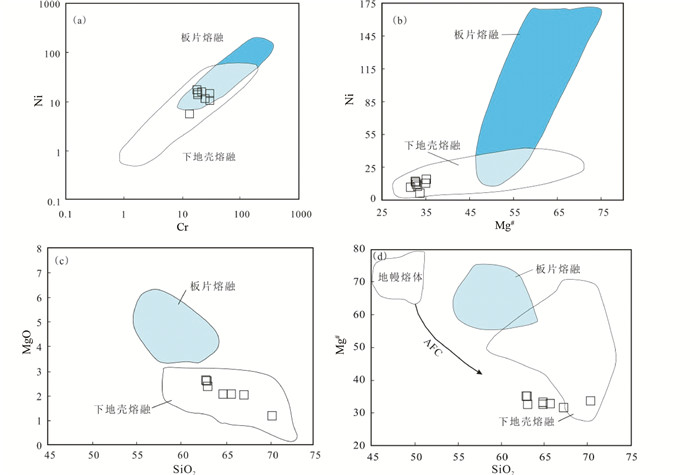
|
图 8 双朋西花岗闪长岩Ni-Cr图 (a)、Ni-Mg#图 (b)、MgO-SiO2图 (c) 和Mg#-SiO2图 (d) 数据来源:(a、b) 板片熔融和下地壳熔融范围据Guan et al. (2012);(c、d) 板片熔融据Zhu et al. (2009),下地壳熔融据Hou et al. (2004); Guo et al. (2007); Gao et al. (2010);AFC-同化混染与分离结晶 (Stern and Kilian, 1996) Fig. 8 Discrimination diagrams of Ni vs. Cr (a), Ni vs. Mg# (b), MgO vs. SiO2 (c) and Mg# vs. SiO2 (d) for the Shuangpengxi granodiorite |
在内生金属矿床研究中,致矿侵入体的识别是一个关键环节 (Meinert, 1992; 罗照华等, 2010),对于矽卡岩型矿床尤其如此 (江秀敏等, 2014)。通过岩体与围岩的接触界限关系 (图 2b、图 3a),花岗闪长岩中存在的隐晶质结构和似斑状结构 (图 3c) 以及花岗闪长岩中浸染状金属矿化 (图 3e) 显示出双朋西花岗闪长岩具有致矿侵入体的特点。由于岩浆系统中残留锆石的保存和同岩浆锆石的晶出与晶体-熔体和晶体-流体的反应速率有关 (Harley et al., 2007),火成岩中有可能出现残留锆石的数量多于同岩浆锆石的情况。因此,同岩浆锆石的识别在锆石U-Pb年代学中具有重要的意义 (张健等, 2014; 钟长汀等, 2014; 刘艳宾等, 2014; 罗明非等, 2014; 罗照华等, 2014)。本文测试的花岗闪长岩样品的锆石为自形晶,具有明显的振荡环带,所有锆石Th/U比值均大于0.4(0.68~1.36),具有典型的岩浆岩锆石特点,指示其为火成岩结晶锆石,锆石的自形程度高暗示未经过长距离搬运。根据锆石阴极发光图像和高的Th/U比值分析,锆石未受到变质作用的影响。本文获得双朋西金铜矿床花岗闪长岩LA-ICP-MS锆石U-Pb最小年龄为233.9±2.8Ma,与区域西秦岭三叠纪构造岩浆作用和成矿时代一致。
5.2 岩浆类型及成因双朋西花岗闪长岩中缺少富铝矿物 (如白云母,电气石和石榴石),具有低的A/CNK值 ( < 1.1,图 6b) 且P2O5含量随着SiO2含量的增加而减少 (图 6d),均显示了I型花岗岩特征 (Chappell and White, 1992; Barbarin, 1999; Chappell, 1999; Clemens et al., 2011; Guillot et al., 2012)。这与前人研究同仁地区花岗闪长岩多为I型花岗岩类 (Li et al., 2015) 的获得的认识一致。
双朋西花岗闪长岩表现为Nb、Ta亏损,大离子亲石元素 (LILE) 和轻稀土元素 (LREE) 强烈富集 (图 7),暗示有壳源物质大量参与 (Barth et al., 2000)。花岗闪长岩的Nb/Ta比值 (5.5~12.9) 明显低于上地幔平均值 (17.5, Weyer et al., 2003),接近大陆地壳的比值 (10~14, 赵振华等, 2008),表明这对元素已经开始分馏,是一种陆壳成因类型。双朋西花岗闪长岩Ni-Cr、Ni-Mg#、MgO-SiO2和Mg#-SiO2图解均显示其来源于下地壳熔融作用,而非板片熔融作用 (图 8),且花岗闪长岩具有较高的K2O含量,较低的MgO含量及Mg#值 (< 0.5, Rapp and Watson, 1995),以及低含量的相容元素 (Cr、Ni、Co、V),明显不同于俯冲大洋板片脱水所释放流体交代上覆楔形地幔,并诱发软流圈地幔部分熔融而形成的钙碱性岩浆 (孙祥等, 2013)。Nb/U和Ce/Pb比值分别为1.2~9.3和3.0~11.6,类似于陆壳 (Nb/U=6.2, Ce/Pb=3.9, Rudnick and Fountain, 1995),而明显不同于洋中脊玄武岩 (MORB) 和洋岛玄武岩 (OIB)(Nb/U=47, Ce/Pb=27, Hofmann et al., 1986),表明双朋西花岗闪长岩来自于陆壳物质。实验岩石学证明,花岗岩的高钾钙碱性、I型特征可能主要取决于源区性质 (Roberts and Clemens, 1993; Rapp and Watson, 1995)。双朋西花岗闪长岩总体化学成分偏于基性,岩石为准铝质,类似于I型花岗岩的化学组成,反映花岗岩类的岩浆主要来自于地壳中火成物质的部分熔融。
双朋西花岗闪长岩具有较高的 (87Sr/86Sr)i初始值 (0.708299~0.708748) 和负的εNd(t) 值 (-12.6~-9.47),εNd(t)-Isr图解 (图 9a) 中投点位置接近于西秦岭三叠纪花岗岩 (Zhang et al., 2007)、西秦岭印支期岩浆岩 (Luo et al., 2012; 张宏飞等, 2006) 和东昆仑印支期岩浆岩 (陈宣华等, 2011; 刘成东等, 2003) 的Sr、Nd范围,结合Nd的模式年龄为1.78~1.88Ga,可能说明该源区的这种火成物质为早-中元古界地壳的组成部分。207Pb/204Pb-206Pb/204Pb图解 (图 9b) 中显示双朋西花岗闪长岩中Pb同位素投点落入下部大陆地壳和富集地幔交界区域,进一步暗示早-中元古界壳源物质的部分熔融过程中有富集地幔物质的混入。野外地质调查发现双朋西花岗闪长岩中具有暗色微粒包体,具有岩浆混合的组构特征。前人通过对同仁地区尖扎岩体 (Li et al., 2014b) 和岗察岩体 (Guo et al., 2012; Luo et al., 2012) Hf同位素研究,发现两个岩体均有年轻地幔物质和古老壳源物质的成分混合的特点,只是两种端元比例有所不同。

|
图 9 双朋西花岗闪长岩Sr-Nd-Pb图解 (a) 西秦岭三叠纪花岗岩数据引自Zhang et al. (2007);青海西秦岭印支岩浆岩数据引自Luo et al. (2012), 张宏飞等 (2006);东昆仑印支期岩浆岩陈宣华等 (2011)、刘成东 (2003);东秦岭三叠纪花岗岩引自Zhang et al. (2007)、Qin et al. (2010b)和Jiang et al. (2010);ISr和εNd(t) 值的计算年龄t=239.4Ma;(b) 底图据Rollison (1993) Fig. 9 εNd(t) versus (87Sr/86Sr)t and Pb isotopic plots of the batholiths from Shuangpengxi areas |
一般来说,酸性岩成分与其源区关系密切,样品中Ba、Sr强烈亏损,反映了可能多是壳源物质低程度部分熔融的产物 (Harris and Lnger, 1992)。实验岩石学证明,地壳中玄武质岩石的部分熔融产生化学成分偏基性的准铝质花岗岩类 (Beard and Lofgren, 1991; Rapp and Watson, 1995; Johannes and Holtz, 1996; Sisson et al., 2005),而地壳中碎屑岩类部分熔融产生化学成分偏酸性的过铝质花岗岩类 (Johannes and Holtz, 1996; Patiño-Douce and Harris, 1998; Patiño-Douce and McCarty, 1998)。双朋西花岗闪长岩总体化学成分偏于基性,有准铝质-弱过铝质特征,可能为玄武岩地壳部分熔融的产物。所有样品数据均显示低的Al2O3/(FeOT+MgO+TiO2) 比值特征,在Al2O3+FeOT+MgO+TiO2-Al2O3/(FeOT+MgO+TiO2) 图解中,所有投点均落入角闪岩部分熔融区域 (Patiño-Douce, 1999),进一步表明双朋西花岗闪长岩主要起源于玄武岩-火成岩岩石的部分熔融 (图 10)。
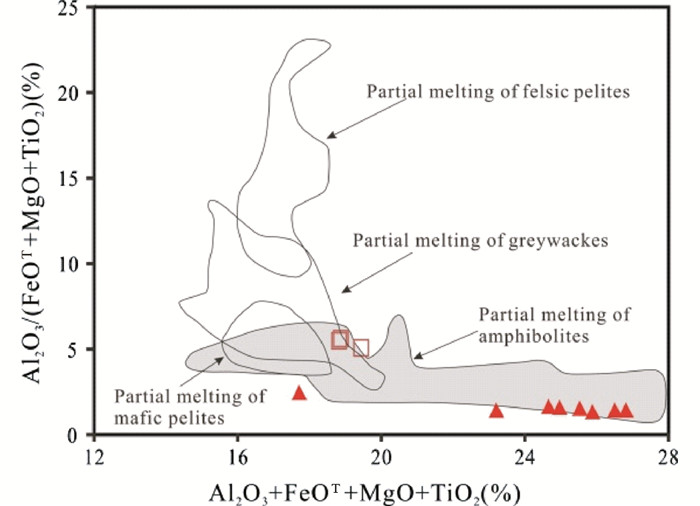
|
图 10 双朋西花岗闪长岩 (Al2O3+FeOT+MgO+TiO2)-Al2O3/(FeOT+MgO+TiO2) 图解 (据Patiño Douce, 1999) FeOT=(Fe2O3×0.9+FeO)×0.899 Fig. 10 Plot of (Al2O3+FeOT+MgO+TiO2) vs. Al2O3/(FeOT+MgO+TiO2) for the Shuangpengxi granodiorite (after Patiño Douce, 1999) |
Moyen and Stevens (2006)总结了几乎所有关于角闪岩部分熔融的实验数据,认为低钾镁铁质岩石部分熔融的产物往往具有低K2O含量且Na2O/K2O>1。但含水的钙碱性-高钾钙碱性和镁铁质-中等变质类岩石发生部分熔融往往形成中-高钾钙碱性花岗岩类岩浆 (Roberts and Clemens, 1993; Sisson et al., 2005)。双朋西花岗闪长岩的Na2O和K2O含量较高,且Na2O/K2O<1,在K2O-SiO2图解 (图 6c) 上显示为高钾钙碱性特征,暗示源区的发生部分熔融的玄武岩为高钾性。双朋西金铜矿床花岗岩闪长岩稀土元素配分模式图 (图 7a) 显示HREE较平坦,MREE较富集,Y/Yb为7.6~9.7,(Ho/Yb)N为0.74~1.06(表 2),指示源区为角闪石残留相 (Wu et al., 2002; Xie et al., 2006);但稀土元素具有弱Eu负异常特点,暗示源区可能有斜长石残留相存在。双朋西花岗闪长岩显示较高的K2O含量,Rb/Sr为0.46~0.83,Ba/Rb比值为1.97~3.94,指示源区可能存在富钾矿物相 (金云母、富钾角闪石和钾长石),且富钾矿物相主要为金云母 (Furman and Graham, 1999)。
因此,双朋西花岗闪长岩主要起源于早-中元古界古老地壳中高钾性玄武岩的部分熔融,并且具有少量的幔源物质混入。
印支早期阿尼玛卿-勉略洋壳向北俯冲时曾发生折返 (Li et al., 2015) 和断离 (Luo et al., 2012)。与板片断离作用有关的岩浆岩多呈线性分布,且经常造成地壳沿着平行于缝合带的方向发生抬升 (Blanckenburg and Davies, 1995; Altunkaynak, 2007; Neilson et al., 2009; Duretz et al., 2011)。印支早期花岗岩主体在西秦岭和东昆仑均有呈东西向的线性展布的特征 (罗明非等, 2014; Luo et al., 2012)。中三叠世为西秦岭海相沉积和陆相沉积的转折点,且地壳的快速隆升而导致的西秦岭北部中三叠世上部 (拉丁阶) 地层的缺失也反映了俯冲板片断离作用的存在 (Buiter et al., 2002; Rogers et al., 2002; Gerya et al., 2004)。俯冲板片断离引起软流圈物质上涌注入下地壳底部,引起下地壳地热异常而发生部分熔融形成长英质岩浆可能为双朋西花岗闪长岩形成的主要机制。
5.3 大地构造意义印支期花岗闪长岩在西秦岭造山带广泛分布。尽管前人对其进行了大量研究,取得了一些成果和认识,但关于花岗闪长岩形成的构造环境依然争论较大。争论的焦点主要是西秦岭下部洋壳向北俯冲的时间限制的不同。一些学者认为西秦岭花岗闪长岩形成于俯冲带环境 (Meng et al., 2005; 闫臻等, 2012; Guo et al., 2012; Li et al., 2014a, b, 2015),而另一些学者认为其形成于同碰撞或者后碰撞环境 (张宏飞等, 2006; Luo et al., 2012; Yang et al., 2013)。
前人通过对比研究东秦岭和西秦岭三叠纪沉积岩,认为东秦岭下三叠统安妮期岩序形成于浅海相;但在西秦岭中部,这种浅海相直到早拉丁阶 (237~228Ma) 还可以被发现,陆相沉积大量出露于晚三叠世 (Meng et al., 2005)。由此进一步认为,东秦岭在中三叠世的时候,扬子板块和华北板块碰撞闭合,但是阿尼玛卿洋在西秦岭依然为俯冲。西秦岭西北部拉丁阶出现地层缺失 (Meng et al., 2005),推测在该地区因为下部俯冲板片折返断裂导致上覆地壳的突然抬升的时间为中三叠世 (Buiter et al., 2002; Rogers et al., 2002; Gerya et al., 2004)。西秦岭东部地区发生同碰撞的时间为ca. 234~220Ma (Qin et al., 2010b; Dong et al., 2012; Li et al., 2013)。Li et al. (2014b)认为同仁地区的尖扎岩体 (~242Ma) 形成于弧后伸展环境,并推测在这种环境因下部俯冲板片折返而诱使地幔对流导致。这种弧后伸展环境在西秦岭的北部也被发现 (Li et al., 2014a)。郭现轻等 (2011)研究认为岗察岩体北部谢坑辉长闪长岩 (243.8±1.0Ma) 和角闪安山岩 (242.1±1.2Ma) 均形成于活动大陆边缘环境。西秦岭、东昆仑和秦岭造山带中的安第斯型花岗岩锆石Lu-Hf同位素研究显示其形成于蛇绿岩的部分熔融,为俯冲岛弧岩浆岩提供证据 (肖庆辉等, 2002; Guo et al., 2012; Li et al., 2013)。夏河东部侵入岩黑云母40Ar/39Ar年龄研究发现岩浆快速冷却 (17.75℃/Myr) 的时间为240~230Ma之间 (郑德文等, 2004),为板片断离引起的地幔软流圈上升环境所致。三叠纪沉积岩中有大量Cr-尖晶石、辉石和火山碎屑物质,伴随有较高的Cr-Ni异常 (闫臻等, 2008, 2012),和正的εNd值 (闫臻等, 2012; Zhang et al., 2012b),说明沉积岩中有与俯冲环境有关的蛇绿岩套或镁铁质物质混入,也指示了西秦岭三叠纪的岛弧或活动大陆边缘环境 (Cawood, 1991; Decou et al., 2011)。
然而,部分学者也提出了西秦岭在印支期不是活动大陆边缘环境的众多证据。张宏飞等 (1999)、Meng and Zhang (2000)和张国伟等 (2001)认为华北板块与扬子板块发生全面碰撞的时间为晚古生代末期。勉略带蛇绿岩变质年龄为242~221Ma,说明至少在印支早期该地区勉略洋已经发生闭合 (Li et al., 1996)。三叠纪时期,东昆仑、西秦岭以及祁连造山带是一个有机整体 (闫臻等, 2008, 2012; Zhang et al., 2012a),东昆仑晚二叠统歌曲组和中二叠统树维门科组之间存在区域角度不整合,晚歌曲组为一典型的磨拉石组,包含了长兴阶地层生物聚结 (254~251Ma),也角度不整合于阿尼玛卿缝合带蛇绿岩混合物之上,指示阿尼玛卿洋的闭合和陆陆碰撞的开始 (任纪舜, 2004; 陈守建等, 2010)。张宏飞等 (2006)研究认为共和盆地周缘印支早期花岗岩类 (如黑马河岩体,235±2Ma) 也形成于俯冲陆壳断离的地球动力学背景。西秦岭北部存在埃达克岩和喜马拉雅型花岗岩,说明三叠纪时期存在陆陆碰撞或陆陆俯冲导致的地壳加厚,加厚的下地壳的部分熔融以及部分熔融发生深度的不同,形成本区具有埃达克或喜马拉雅型地球化学特点的花岗岩侵入体 (徐学义等, 2014)。
其实,三叠纪的秦岭恰似现今地中海,并存着洋陆俯冲和陆陆碰撞,并逐渐由洋陆俯冲转变为陆陆碰撞体制 (陈衍景, 2010)。俯冲-增生杂岩、岛弧、弧前/弧后盆地等一系列造单元均可被识别出来 (Wu et al., 1993; Yan et al., 2006, 2010; Xiao et al., 2009; 孟繁聪等, 2005),于是这些造山带被认为是具有“多陆块、多岛弧”结构特征且呈现出“多洋 (海) 盆、多俯冲、多碰撞和多造山”的动力学作用过程 (许志琴等, 2006),在与古特提斯洋发育的秦-祁昆地区具有代表性,并被解释为由俯冲增生造山作用和碰撞造山作用共同形成的复合型 (杨经绥等, 2010; 王宗起等, 2009; 许志琴等, 2006; 张国伟等, 2001; 闫臻等, 2012) 造山带。
通过对前人观点的详细总结和本文的研究认为,印支期两种构造环境在西秦岭地区具有并行存在的特征,只是在局部区域表现为某种构造现象更为突出。从印支的早期到晚期,随着时间的推移逐渐由洋壳俯冲向陆陆俯冲或陆陆碰撞转换。岗察岩体从东向西的岩性也有明显由中基性逐渐向中酸性演化的趋势 (闪长岩→花岗闪长岩→二长花岗岩及斑状花岗岩)(陶志华等, 2014),不同岩性岩石的形成年龄和地球化学特征以及Sr-Nd-Hf同位素组成等也显著不同 (张涛, 2007; 息朝庄, 2009; 郭现轻等, 2011; Luo et al., 2012; 孙小攀等, 2013; 徐学义等, 2014)。岗察岩体东部的辉长闪长岩 (243.8±1.0Ma) 和辉长岩 (242.1±1.2Ma) 形成于因古特提斯洋向北俯冲而形成的活动大陆边缘环境 (郭现轻等, 2011),而岗察岩体西部的二长花岗岩 (215±3Ma, 张涛等, 2014) 的形成是因增厚下地壳的部分熔融 (徐学义等, 2014) 或后碰撞期由挤压向伸展环境转换。位于岗察岩体中部的双朋西花岗闪长岩 (233.9±2.8Ma, 本文),在花岗岩的构造环境判别图解中,所有样品投点均落于岛弧和同碰撞花岗岩交界处 (图 11),已经显现出由洋壳俯冲向陆陆俯冲环境转换的特征。

|
图 11 双朋西花岗闪长岩体构造环境判别图 (据Pearce et al., 1984) Post-COLG-后碰撞花岗岩;WPG-板内花岗岩;VAG-火山弧花岗岩;Syn-COLG-同碰撞花岗岩;ORG-洋脊花岗岩 Fig. 11 Diagrams of the tectonic setting of trace elements for the Shuangpengxi intrusion (after Pearce et al., 1984) |
双朋西花岗闪长岩的锆石年龄和岩石成因研究推测西秦岭地区在233.9Ma时还处于洋壳俯冲向陆陆碰撞的转换阶段。通过对西秦岭早-中三叠世侵入岩的研究,说明西秦岭地区在俯冲到碰撞的转换过程中,先有俯冲板片的折返和断离,引起软流圈物质上涌注入下地壳底部,引起下地壳地热异常而发生部分熔融形成长英质岩浆。因此,双朋西花岗闪长岩体的岩石地球化学与年代学,为探索西秦岭地区中三叠世早期的构造格局和形成演化提供了重要信息。
6 结论(1) 与双朋西矽卡岩型金铜矿床相关的花岗闪长岩SiO2平均含量为65.26%,(K2O+Na2O) 平均含量为6.42%,Na2O平均含量为2.65%,具有较低的Al2O3(12.54%~15.71%) 和较低的MgO含量 (1.17%~2.62%) 及Mg#值 (33.1~35.1),K2O含量为3.35%~5.01%,为富钾钙碱性I型花岗岩。
(2) 双朋西花岗闪长岩起源于早-中元古界古老地壳中高钾性玄武岩的部分熔融,并具有少量幔源物质的贡献。
(3) 双朋西花岗闪长岩锆石LA-ICP-MS U-Pb年龄为233.9±2.8Ma,可能为中三叠世俯冲板片断离诱发地幔软流圈上涌加热上覆下地壳使之发生部分熔融的产物,这一时期西秦岭构造带可能处于由洋壳俯冲向陆陆碰撞过度阶段。
致谢 野外工作得到青海省同仁县水文站全体工作人员的大力支持;样品LA-ICP-MS锆石U-Pb定年在中国科学技术大学壳幔物质与环境重点实验室侯振辉教授的指导下完成;岩体主微量元素测试过程中得到核工业北京地质研究院分析测试研究所刘牧老师的大力帮助。在论文撰写与修改过程中,得到武警黄金研究所的葛良胜、郭晓东、王梁高级工程师以及秦克章研究员、两位匿名审稿专家的具体指导和帮助。在此致以衷心的感谢!| [] | Altunkaynak S. 2007. Collision-driven slab break off magmatism in Northwestern Anatolia, Turkey. The Journal of Geology, 115(1): 63–82. DOI:10.1086/509268 |
| [] | Andersen T. 2002. Correction of common lead in U-Pb analyses that do not report 204Pb. Chemical Geology, 192(1-2): 5979. |
| [] | Annikova IY, Vladimirov AG, Vystavnoi SA, Zhuravlev DZ, Kruk NN, Lepekhina EN, Matukov DI, Moroz EN, Palesskii SV, Ponomarchuk VA, Rudnev SN, Sergeev SA. 2006. U-Pb, and 39Ar/40Ar dating and Sm-Nd, and Pb-Pb isotopic study of the Kalguty Molybdenum-tungsten ore-magmatic system. Southern Altai Petrology, 14(1): 81–97. |
| [] | Barbarin B. 1999. A review of the relationships between granitoid types, their origins and their geodynamic environments. Lithos, 46(3): 605–626. DOI:10.1016/S0024-4937(98)00085-1 |
| [] | Barth MG, McDonough WF, Rudnck RL. 2000. Tracking the budget of Nb and Ta in the continental crust. Chemical Geology, 165(3-4): 197–213. DOI:10.1016/S0009-2541(99)00173-4 |
| [] | Beard JS, Lofgren GE. 1991. Dehydration melting and water-saturated melting of basaltic and andesitic greenstones and amphibolites at 1, 3, and 6. 9kb. Journal of Petrology, 32(2): 365–401. DOI:10.1093/petrology/32.2.365 |
| [] | Belousova EA, Griffin WL, O'Reilly SY, Fisher NI. 2002. Igneous zircon:Trace element composition as an indicator of source rock type. Contributions to Mineralogy and Petrology, 143(5): 602–622. DOI:10.1007/s00410-002-0364-7 |
| [] | Buiter SJH, Govers R, Wortel MJR. 2002. Two-dimensional simulations of surface deformation caused by slab detachment. Tectonophysics, 354(3-4): 195–210. DOI:10.1016/S0040-1951(02)00336-0 |
| [] | Cao XF, Lü XB, Yao SZ, Mei W, Zou XY, Chen C, Liu ST, Zhang P, Su YY, Zhang B. 2011. LA-ICP-MS U-Pb zircon geochronology, geochemistry and kinetics of the Wenquan ore-bearing granites from West Qinling, China. Ore Geology Reviews, 43(1): 120–131. DOI:10.1016/j.oregeorev.2010.03.004 |
| [] | Cawood PA. 1991. Characterisation of intra-oceanic magmatic arc source terranes by provenance studies of derived sediments. New Zealand Journal of Geology and Geophysics, 34(3): 347–358. DOI:10.1080/00288306.1991.9514473 |
| [] | Chappell BW, White AJR. 1992. I-and S-type granites in the Lachlan Fold Belt. Earth Environmental Science Transactions of the Royal Society of Edinburgh, 83(1-2): 1–26. DOI:10.1017/S0263593300007720 |
| [] | Chappell BW. 1999. Aluminium saturation in I-and S-type granites and the characterization of fractionated haplogranites. Lithos, 46(3): 535–551. DOI:10.1016/S0024-4937(98)00086-3 |
| [] | Chen SJ, Li RS, Ji WH, Zhao ZM, Liu RL, Jia BH, Zhang ZF, Wang GC. 2010. The Permian lithofacies paleogeographic characteristics and basin-mountain conversion in the Kunlun orogenic belt. Geology in China, 37(2): 374–393. |
| [] | Chen XH, Yin A, Gehrels G, Li L, Jiang RB. 2011. Chemical geodynamics of granitic magmatism in the basement of the eastern Qaidam Basin, Northern Qinghai-Tibet Plateau. Acta Geologica Sinica, 85(2): 157–171. |
| [] | Chen YJ. 2010. Indosinian tectonic setting, magmatism and metallogenesis in Qinling Orogen, central China. Geology in China, 37(4): 854–865. |
| [] | Clemens JD, Stevens G, Farina F. 2011. The enigmatic sources of Ⅰ-type granites:The peritectic connexion. Lithos, 126(3-4): 174–181. DOI:10.1016/j.lithos.2011.07.004 |
| [] | Decou A, von Eynatten H, Mamani M, Sempere T, Wörner G. 2011. Cenozoic forearc basin sediments in southern Peru (15~18°S):Stratigraphic and heavy mineral constraints for Eocene to Miocene evolution of the Central Andes. Sedimentary Geology, 237(1-2): 55–72. DOI:10.1016/j.sedgeo.2011.02.004 |
| [] | Dong YP, Zhang GW, Neubauer F, Liu XM, Genser J, Hauzenberger C. 2011. Tectonic evolution of the Qinling Orogen, China:Review and synthesis. Journal of Asian Earth Sciences, 41(3): 213–237. DOI:10.1016/j.jseaes.2011.03.002 |
| [] | Dong YP, Liu XM, Zhang GW, Chen Q, Zhang XN, Li W, Yang C. 2012. Triassic diorites and granitoids in the Foping area:Constraints on the conversion from subduction to collision in the Qinling orogen, China. Journal of Asian Earth Sciences, 47: 123–142. DOI:10.1016/j.jseaes.2011.06.005 |
| [] | Duretz T, Gerya TV, May DA. 2011. Numerical modelling of spontaneous slab breakoff and subsequent topographic response. Tectonophysics, 502(1-2): 244–256. DOI:10.1016/j.tecto.2010.05.024 |
| [] | Feng CY, Wang XP, Shu XF, Zhang AK, Xiao Y, Liu JN, Ma SC, Li GC, Li DX. 2011. Isotopic chronology of the Hutouya skarn lead-zinc polymetallic ore district in Qimantage area of Qinghai Province and its geological significance. Journal of Jilin University (Earth Science Edition), 41(6): 1806–1817. |
| [] | Fu XM, Dai TG, Xi CZ, Liu W, Liu X. 2010. Characteristics of ore-forming fluid and genesis of the Shuangpengxi gold-copper deposit in Qinghai Province. Contributions to Geology and Mineral Resources Research, 25(1): 24–29. |
| [] | Furman T, Graham D. 1999. Erosion of lithospheric mantle beneath the East African Rift system:Geochemical evidence from the Kivu volcanic province. Lithos, 48(1-4): 237–262. DOI:10.1016/S0024-4937(99)00031-6 |
| [] | Gao YF, Yang ZS, Santosh M, Hou ZQ, Wei RH, Tian SH. 2010. Adakitic rocks from slab melt-modified mantle sources in the continental collision zone of southern Tibet. Lithos, 119(3-4): 651–663. DOI:10.1016/j.lithos.2010.08.018 |
| [] | Gerya TV, Yuen DA, Maresch WV. 2004. Thermomechanical modelling of slab detachment. Earth and Planetary Science Letters, 226(1-2): 101–116. DOI:10.1016/j.epsl.2004.07.022 |
| [] | Green TH, Pearson NJ. 1986. Rare-earth element partitioning between sphene and coexisting silicate liquid at high pressure and temperature. Chemical Geology, 55(1-2): 105–119. DOI:10.1016/0009-2541(86)90131-2 |
| [] | Guan Q, Zhu DC, Zhao ZD, Dong GC, Zhang LL, Li XW, Liu M, Mo XX, Liu YS, Yuan HL. 2012. Crustal thickening prior to 38Ma in southern Tibet:Evidence from lower crust-derived adakitic magmatism in the Gangdese Batholith. Gondwana Research, 21(1): 88–99. DOI:10.1016/j.gr.2011.07.004 |
| [] | Guillot F, Bertrand JM, Bussy F, Lanari P, Cosma L, Pin C. 2012. Early Variscan Ⅰ-type pluton in the pre-Alpine basement of the Western Alps:The ca. 360Ma Cogne diorite (NW-Italy). Lithos, 153: 94–107. |
| [] | Guo XQ, Yan Z, Wang ZQ, Wang T, Wu FF, Fu CL, Hou KJ, Li JL. 2011. Geological characteristics and associated magmatic ages of the Xiekeng skarn-type Cu-Au deposit in the West Qinling terrane. Acta Petrologica Sinica, 27(12): 3811–3822. |
| [] | Guo XQ, Yan Z, Wang ZQ, Wang T, Hou KJ, Fu CL, Li JL. 2012. Middle Triassic arc magmatim along the northeastern margin of the Tibet:U-Pb and Lu-Hf zircon characterization of the Gangcha complex in the West Qinling terrane, central China. Journal of the Geological Society, 169(3): 327–336. DOI:10.1144/0016-76492011-083 |
| [] | Guo ZF, Wilson M, Liu JQ. 2007. Post-collisional adakites in South Tibet:Products of partial melting of subduction-modified lower crust. Lithos, 96(1-2): 205–224. DOI:10.1016/j.lithos.2006.09.011 |
| [] | Han YW, Ma ZD. 2003. Geochemistry. Beijing: Geological Publishing House: 181-212. |
| [] | Harley SL, Kelly NM, Möller A. 2007. Zircon behaviour and the thermal histories of mountain chains. Elements, 3(1): 25–30. DOI:10.2113/gselements.3.1.25 |
| [] | Harris NBW, Lnger S. 1992. Trace element modeling of pelite-derived granites. Contributions to Mineralogy and Petrology, 110(1): 46–56. DOI:10.1007/BF00310881 |
| [] | Hofmann AW, Jochum KP, Seufert M, White WM. 1986. Nb and Pb in oceanic basalts:New constraints on mantle evolution. Earth and Planetary Science Letters, 79(1-2): 33–45. DOI:10.1016/0012-821X(86)90038-5 |
| [] | Hou ZQ, Gao YF, Qu XM, Rui ZY, Mo XX. 2004. Origin of adakitic intrusives generated during Mid-Miocene east-west extension in southern Tibet. Earth and Planetary Science Letters, 220(1-2): 139–155. DOI:10.1016/S0012-821X(04)00007-X |
| [] | Jerram DA and Martin VM. 2008. Understanding crystal populations and their significance through the magma plumbing system. In:Annen C and Zellmer GF (eds.). Dynamics of Crustal Magma Transfer, Storage and Differentiation. Geological Society, London, Special Publications, 304:133-148 |
| [] | Jiang XM, Luo ZH, Chen BH, Wang ZQ, Zhang Q. 2014. Identification symbols of causing intrusions:For an example of Aerxiati iron-copper skarn deposit, Xinjiang. Acta Petrologica Sinica, 30(11): 3455–3466. |
| [] | Jiang YH, Jin GD, Liao SY, Zhou Q, Zhao P. 2010. Geochemical and Sr-Nd-Hf isotopic constraints on the origin of Late Triassic granitoids from the Qinling orogen, Central China:Implications for a continental arc to continent-continent collision. Lithos, 117(1-4): 183–197. DOI:10.1016/j.lithos.2010.02.014 |
| [] | Jin WJ, Zhang Q, He DF, Jia XQ. 2005. SHRIMP dating of adakites in western Qinling and their implications. Acta Petrologica Sinica, 21(3): 959–966. |
| [] | Johannes W, Holtz F. 1996. Petrogenesis and Experimental Petrology of Granitic Rocks. Berlin: Springer: 1-254. |
| [] | Li L, Meng QR, Pullen A, Garzione CN, Wu GL, Wang YL, Ma SX, Duan L. 2014a. Late Permian-early Middle Triassic back-arc basin development in West Qinling, China. Journal of Asian Earth Sciences, 87: 116–129. DOI:10.1016/j.jseaes.2014.02.021 |
| [] | Li XW, Mo XX, Yu XH, Ding Y, Huang XF, Wei P, He WY. 2013. Petrology and geochemistry of the Early Mesozoic pyroxene andesites in the Maixiu area, West Qinling, China:Products of subduction or syn-collision?. Lithos, 172-173: 158–174. DOI:10.1016/j.lithos.2013.04.010 |
| [] | Li XW, Mo XX, Bader T, Scheltens M, Yu XH, Dong GC, Huang XF. 2014b. Petrology, geochemistry and geochronology of the magmatic suite from the Jianzha Complex, central China:Petrogenesis and geodynamic implications. Journal of Asian Earth Sciences, 95: 164–181. DOI:10.1016/j.jseaes.2014.07.017 |
| [] | Li XW, Mo XX, Huang XF, Dong GC, Yu XH, Luo MF, Liu YB. 2015. U-Pb zircon geochronology, geochemical and Sr-Nd-Hf isotopic compositions of the Early Indosinian Tongren Pluton in West Qinling:Petrogenesis and geodynamic implications. Journal of Asian Earth Sciences, 97: 38–50. DOI:10.1016/j.jseaes.2014.10.017 |
| [] | Li SG, Sun WD, Zhang GW, Chen JY, Yang Y. 1996. Chronology and geochemistry of metavolcanic rocks from Heigouxia Valley in the Mian-Lue tectonic zone, South Qinling:Evidence for a Paleozoic oceanic basin and its close time. Science in China (Series D), 39: 300–310. |
| [] | Liu CD, Mo XX, Luo ZH, Yu XH, Chen HW, Li SW, Zhao X. 2003. Pb-Sr-Nd-O isotope characteristics of granitoids in East Kunlun Orogenic Belt. Acta Geoscientica Sinica, 24(6): 589–588. |
| [] | Liu YB, Mo XX, Zhang D, Que CY, Di YJ, Pu XM, Cheng GS, Ma HH. 2014. Petrogenesis of the Late Cretaceous granite discovered in the Laojunshan region, southeastern Yunnan Province. Acta Petrologica Sinica, 30(11): 3271–3286. |
| [] | Lu YC, Liu JJ, Cao SL, Zhang D, Sun H, Wang B, Zhang WH, Kong YY. 2016. Fluid inclusions study of Shuangpengxi skarn type gold-copper deposit in West Qinling, Qinghai Province. Mineral Deposits, 35(1): 130–152. |
| [] | Ludwig KR. 2003. Isoplot 3.00:A Geochronological Toolkit for Microsoft Excel. Berkeley, CA: Berkeley Geochronology Center: 1-74. |
| [] | Luo BJ, Zhang HF, Lü XB. 2012. U-Pb zircon dating, geochemical and Sr-Nd-Hf isotopic compositions of Early Indosinian intrusive rocks in West Qinling, central China:Petrogenesis and tectonic implications. Contributions to Mineralogy and Petrology, 164(4): 551–569. DOI:10.1007/s00410-012-0748-2 |
| [] | Luo MF, Mo XX, Yu XH, Li XW, Huang XF, Yu JC. 2014. Zircon LA-ICP-MS U-Pb age dating, petrogenesis and tectonic implications of the Late Triassic granites from the Xiangride area, East Kunlun. Acta Petrologica Sinica, 30(11): 3229–3241. |
| [] | Luo ZH, Lu XX, Xu JY, Liu C, Li DD. 2010. Petrographic indicators of the ore-bearing intrusions. Acta Petrologica Sinica, 26(8): 2247–2254. |
| [] | Luo ZH, Yang ZF, Dai G, Cheng LL, Zhou JL. 2013. Crystal populations of igneous rocks and their implications in genetic mineralogy. Geology in China, 40(1): 176–181. |
| [] | Luo ZH, Liu C, Su SG. 2014. Understanding the physical processes in magmatic systems. Acta Petrologica Sinica, 30(11): 3113–3119. |
| [] | Meinert LD. 1992. Skarns and skarn deposits. Geoscience Canada, 19(4): 145–162. |
| [] | Meng FC, Zhang JX, Yang JS. 2005. Subducted continental arc:Geochemical and isotopic evidence of gneisses in the north Qaidam. Acta Geologica Sinica, 79(1): 46–55. |
| [] | Meng QR, Zhang GW. 2000. Geologic framework and tectonic evolution of the Qinling orogen, Central China. Tectonophysics, 323(3-4): 183–196. DOI:10.1016/S0040-1951(00)00106-2 |
| [] | Meng QR, Wang E, Hu JM. 2005. Mesozoic sedimentary evolution of the Northwest Sichuan basin:Implication for continued clockwise rotation of the South China block. Geological Society of America Bulletin, 117(3): 396–410. DOI:10.1130/B25407.1 |
| [] | Middlemost EAK. 1985. Magmas and Magmatic Rocks. London: Longman: 1-266. |
| [] | Middlemost EAK. 1994. Naming materials in the magma/igneous rock system. Earth-Science Reviews, 37(3-4): 215–224. DOI:10.1016/0012-8252(94)90029-9 |
| [] | Möller A, O'Brien PJ, Kennedy A and Kröner A. 2003. Linking growth episodes of zircon and metamorphic textures to zircon chemistry:An example from the ultrahigh-temperature granulites of Rogaland (SW Norway) In:Vance D, Müller W and Villa IM (eds.). Geochromology:Linking the Isotopic Record with Petrology and Textures. Geological Society, London, Special Publications, 220:65-81 |
| [] | Moyen JF and Stevens G. 2006. Experimental constraints on TTG petrogenesis:Implications for Archean geodynamics. In:Benn K, Mareschal JC and Condie KC (eds.). Geophysical Monograph Series:Archean Geodynamics and Environments. Washington:American Geophysical Union, 164:1-28 |
| [] | Neilson JC, Kokelaar BP, Crowley QG. 2009. Timing, relations and cause of plutonic and volcanic activity of the Siluro-Devonian postcollision magmatic episode in the Grampian Terrane, Scotland. Journal of the Geological Society, 166(3): 545–561. DOI:10.1144/0016-76492008-069 |
| [] | Patiño-Douce AE, Harris N. 1998. Experimental constraints on Himalavan anatexis. Journal of Petrology, 39(4): 689–710. DOI:10.1093/petroj/39.4.689 |
| [] | Patiño-Douce AE and McCarthy TC. 1998. Melting of crustal rocks during continental collision and subduction. In:Hacker BR and Liu JG (eds.). When Continents Collide:Geodynamics and Geochemistry of Ultrahigh-Pressure Rocks, Petrology and Structural Geology. Netherlands:Springer, 10:27-55 |
| [] | Patiño-Douce AE. 1999. What do experiments tell us about the relative contributions of crust and mantle to the origin of granitic magmas? In:Fernández AA and Vigneresse JL (eds.). Understanding Granites:Integrating New and Classical Techniques. Geological Society, London, Special Publications, 168(1):55-75 |
| [] | Pearce JA, Harris NBW, Tindle AG. 1984. Trace element discrimination diagrams for the tectonic interpretation of granitic rocks. Journal of Petrology, 25(4): 956–983. DOI:10.1093/petrology/25.4.956 |
| [] | Peccerillo R, Taylor SR. 1976. Geochemistry of Eocene calc-alkaline volcanic rocks from the Kastamonu area, Northern Turkey. Contributions to Mineralogy and Petrology, 58(1): 63–81. DOI:10.1007/BF00384745 |
| [] | Qin JF, Lai SC, Diwu CR, Ju YJ, Li YF. 2010a. Magma mixing origin for the post-collisional adakitic monzogranite of the Triassic Yangba pluton, northwestern margin of the South China block:Geochemistry, Sr-Nd isotopic, zircon U-Pb dating and Hf isotopic evidences. Contributions to Mineralogy and Petrology, 159(3): 389–409. DOI:10.1007/s00410-009-0433-2 |
| [] | Qin JF, Lai SC, Grapes R, Diwu CR, Ju YJ, Li YF. 2010b. Origin of Late Triassic high-Mg adakitic granitoid rocks from the Dongjiangkou area, Qinling Orogen, central China:Implications for subduction of continental crust. Lithos, 120(3-4): 347–367. DOI:10.1016/j.lithos.2010.08.022 |
| [] | Rapp RP, Watson EB. 1995. Dehydration melting of metabasalt at 8~32kbar:Implications for continental growth and crust-mantle recycling. Journal of Petrology, 36(4): 891–931. DOI:10.1093/petrology/36.4.891 |
| [] | Ren JS. 2004. Some problems on the Kunlun-Qinling orogenic system. Northwestern Geology, 37(1): 1–5. |
| [] | Roberts MP, Clemens JD. 1993. Origin of high-potassium, calc-alkaline, Ⅰ-type granitoids. Geology, 21(9): 825–828. DOI:10.1130/0091-7613(1993)021<0825:OOHPTA>2.3.CO;2 |
| [] | Rogers RD, Kárason H, Van Der Hilst RD. 2002. Epeirogenic uplift above a detached slab in northern Central America. Geology, 30(11): 1031–1034. DOI:10.1130/0091-7613(2002)030<1031:EUAADS>2.0.CO;2 |
| [] | Rollison HR. 1993. Using Geochemical Data:Evaluation, Presentation, Interpretation. New York: Longman Publishing Group: 1-352. |
| [] | Rubatto D and Gebauer D. 2000. Use of cathodoluminescence for U-Pb zircon dating by ion microprobe:Some examples from the western Alps. In:Pagel M, Barbin V, Blanc P and Ohnenstetter D (eds.). Cathodoluminescence in Geosciences. Berlin Heidelberg:Springer-Verlag, 373-400 |
| [] | Rubatto D. 2002. Zircon trace element geochemistry:Partitioning with garnet and the link between U-Pb age and metamorphism. Chemical Geology, 184(1-2): 123–138. DOI:10.1016/S0009-2541(01)00355-2 |
| [] | Rudnick RL, Fountain DM. 1995. Nature and composition of the continental crust:A lower crustal perspective. Reviews of Geophysics, 33(3): 267–309. DOI:10.1029/95RG01302 |
| [] | Shand SJ. 1943. Eruptive Rocks:Their Genesis, Composition, Classification, and Their Relation to Ore-deposits, with a Chapter on Meteorites. New York: Wiley: 1-444. |
| [] | Sisson TW, Ratajeski K, Hankins WB. 2005. Voluminous granitic magmas from common basaltic sources. Contributions to Mineralogy and Petrology, 148(6): 635–661. DOI:10.1007/s00410-004-0632-9 |
| [] | Stern CR, Kilian R. 1996. Role of the subducted slab, mantle wedge and continental crust in the generation of adakites from the Andean Austral Volcanic Zone. Contributions to Mineralogy and Petrology, 123(3): 263–281. DOI:10.1007/s004100050155 |
| [] | Sun WD, Li SG, Chen YD, Li YJ. 2002. Timing of synorogenic granitoids in the South Qinling, Central China:Constraints on the evolution of the Qinling-Dabie Orogenic Belt. The Journal of Geology, 110(4): 457–468. DOI:10.1086/340632 |
| [] | Sun X, Zheng YY, Wu S, You ZM, Wu X, Li M, Zhou TC, Dong J. 2013. Mineralization age and petrogenesis of associated intrusions in the Mingze-Chengba porphyry-skarn Mo-Cu deposit, Gangdese. Acta Petrologica Sinica, 29(4): 1392–1406. |
| [] | Sun XP, Xu XY, Chen JL, Gao T, Li T, Li XB, Li XY. 2013. Geochemical characteristics and chronology of the Jiangligou granitic pluton in West Qinling and their geological significance. Acta Geologica Sinica, 87(3): 330–342. |
| [] | Tao ZH, Yuan HX, Liu QY, Wang QH. 2014. Geochemical characteristics and significance of the Gangcha complex in the West Qinling. Geology and Exploration, 50(3): 543–549. |
| [] | von Blanckenburg F, Davies JH. 1995. Slab breakoff:A model for syncollisional magmatism and tectonics in the Alps. Tectonics, 14(1): 120–131. DOI:10.1029/94TC02051 |
| [] | Wang S, Feng CY, Li SJ, Jiang JH, Li DS, Su SS. 2009. Zircon SHRIMP U-Pb dating of granodiorite in the Kaerqueka polymetallic ore deposit, Qimantage Mountain, Qinghai Province, and its geological implications. Geology in China, 36(1): 74–84. |
| [] | Wang XD, Yang ZX, Yan B. 2010. Geological characteristics and prospecting criteria of the Saishitang copper deposit in Qinghai Province. Sichuan Nonferrous Metals, 2(2): 10–14. |
| [] | Wang ZQ, Yan QR, Yan Z, Wang T, Jiang CF, Gao LD, Li QG, Chen JL, Zhang YL, Liu P, Xie CL, Xiang ZJ. 2009. New division of the main tectonic units of the Qinling Orogenic Belt, Central China. Acta Geologica Sinica, 83(11): 1527–1546. |
| [] | Watanabe M, Nishido H, Moriwaki H, Higashimoto S, Kubota Y. 1988. K-Ar ages of skarn deposits in the Inner zone of southwestern Japan. Geochemical Journal, 22(5): 231–236. DOI:10.2343/geochemj.22.231 |
| [] | Wei P, Mo XX, Yu XH, Huang XF, Ding Y, Li XW. 2013. Geochemistry, chronology and geological significance of the granitoids in Xiahe, West Qinling. Acta Petrologica Sinica, 29(11): 3981–3992. |
| [] | Weyer S, Münker C, Mezger K. 2003. Nb/Ta, Zr/Hf and REE in the depleted mantle:Implications for the differentiation history of the crust-mantle system. Earth Planetary Science Letters, 205(3-4): 309–324. DOI:10.1016/S0012-821X(02)01059-2 |
| [] | Wolf MB, London D. 1994. Apatite dissolution into peraluminous haplogranitic melts:An experimental study of solubilities and mechanisms. Geochimica et Cosmochimica Acta, 58(19): 4127–4145. DOI:10.1016/0016-7037(94)90269-0 |
| [] | Wu FY, Sun DY, Li HM, Jahm BM, Wilde S. 2002. A-type granites in northeastern China:Age and geochemical constraints on their petrogenesis. Chemical Geology, 187(1-2): 143–173. DOI:10.1016/S0009-2541(02)00018-9 |
| [] | Wu HQ, Feng YM, Song SG. 1993. Metamorphism and deformation of blueschist belts and their tectonic implications, North Qilian Mountains, China. Journal of Metamorphic Geology, 11(4): 523–536. DOI:10.1111/jmg.1993.11.issue-4 |
| [] | Wu YB, Zheng YF. 2004. Genesis of zircon and its constraints on interpretation of U-Pb age. Chinese Science Bulletin, 49(15): 1554–1569. DOI:10.1007/BF03184122 |
| [] | Xi CZ. 2009. Research on the Geological-geochemical characteristics and metallogenic prognosis in the Shuangpengxi deposit area, Tongren, Qinghai Province. Ph. D. Dissertation. Changsha:Central South University, 1-102 (in Chinese with English summary) |
| [] | Xiao QH, Deng JF, Ma DQ, Hong DW, Mo XX, Lu XX, Li ZC, Wang XW, Ma CQ, Wu FY, Luo ZH, Wang T. 2002. The Ways of Investigation on Granitoids. Beijing: Geological Publishing House: 1-294. |
| [] | Xiao WJ, Windley BF, Yong Y, Yan Z, Yuan C, Liu CZ, Li JL. 2009. Early Paleozoic to Devonian multiple-accretionary model for the Qilian Shan, NW China. Journal of Asian Earth Sciences, 35(3-4): 323–333. DOI:10.1016/j.jseaes.2008.10.001 |
| [] | Xie CF, Zhu JC, Ding SJ, Zhang YM, Fu TA, Li ZH. 2006. Identification of Hercynian shoshonitic intrusive rocks in central Hainan Island and its geotectonic implications. Chinese Sciences Bulletin, 51(20): 2507–2519. DOI:10.1007/s11434-006-2122-0 |
| [] | Xu XY, Chen JL, Gao T, Li P, Li T. 2014. Granitoid magmatism and tectonic evolution in northern edge of the Western Qinling terrane, NW China. Acta Petrologica Sinica, 30(2): 371–389. |
| [] | Xu ZQ, Yang JS, Li HB, Zhang JX, Zeng LS, Jiang M. 2006. The Qinghai-Tibet Plateau and continental dynamics:A review on terrain tectonics, collisional orogenesis, and processes and mechanisms for the rise of the plateau. Geology in China, 33(2): 221–238. |
| [] | Xue J, Dai TG, Xi CZ. 2012. Geological features and genesis of the Shuangpengxi gold deposit in Tongren, Qinghai Province. Acta Petrologica et Mineralogica, 31(1): 28–38. |
| [] | Yan Z, Wang ZQ, Wang T, Yan QR, Xiao WJ, Li JL. 2006. Provenance and tectonic setting of clastic deposits in the Devonian Xicheng Basin, Qinling orogen, central China. Journal of Sedimentary Research, 76(3): 557–574. DOI:10.2110/jsr.2006.046 |
| [] | Yan Z, Bian QT, Korchagin OA, Pospelov Ⅱ, Li JL, Wang ZQ. 2008. Provenance of Early Triassic Hongshuichuan Formation in the southern margin of the East Kunlun Mountains:Constrains from detrital framework, heavy mineral analysis and geochemistry. Acta Petrologica Sinica, 24(5): 1068–1078. |
| [] | Yan Z, Xiao WJ, Windley BF, Wang ZQ, Li JL. 2010. Silurian clastic sediments in the North Qilian Shan, NW China:Chemical and isotopic constraints on their forearc provenance with implications for the Paleozoic evolution of the Tibetan Plateau. Sedimentary Geology, 231(3-4): 98–114. DOI:10.1016/j.sedgeo.2010.09.001 |
| [] | Yan Z, Wang ZQ, Li JL, Xu ZQ, Deng JF. 2012. Tectonic settings and accretionary orogenesis of the West Qinling Terrane, northeastern margin of the Tibet Plateau. Acta Petrologica Sinica, 28(6): 1808–1828. |
| [] | Yan Z, Guo XQ, Fu CL, Aitchison J, Wang ZQ, Li JL. 2014. Detrital heavy mineral constraints on the Triassic tectonic evolution of the West Qinling Terrane, NW China:Implications for understanding subduction of the Paleotethyan Ocean. The Journal of Geology, 122: 591–608. DOI:10.1086/677264 |
| [] | Yang JS, Xu ZQ, Ma CQ, Wu CL, Zhang JX, Wang ZQ, Wang GC, Zhang HF, Dong YP, Lai SC. 2010. Compound orogeny and scientific problems concerning the Central Orogenic Belt of China. Geology in China, 37(1): 1–11. |
| [] | Yang T, Zhu LM, Wang F, Gong HJ, Lu RK. 2013. Geochemistry, petrogenesis and tectonic implications of granitic plutons at the Liziyuan orogenic gold field in the Western Qinling Orogen, central China. Geological Magazine, 150(1): 50–71. DOI:10.1017/S0016756812000283 |
| [] | Yu YS, Gao Y, Yang ZS, Tian SH, Liu YC, Cao SH, Hu WZ, Qie HM. 2011. Zircon LA-ICP-MS U-Pb dating and geochemistry of intrusive rocks from Gunjiu iron deposit in the Nixiong ore field, Coqen, Tibet. Acta Petrologica Sinica, 27(7): 1949–1960. |
| [] | Zhang GW. 1991. A discussion on basic features of tectonic development of lithosphere of the Qinling Belt. Journal of Northwest University, 21(2): 77–87. |
| [] | Zhang GW, Zhang BR, Yuan XC, Xiao QH. 2001. Qinling Orogenic Belt and Continental Dynamics. Beijing: Science Press: 1-855. |
| [] | Zhang GW, Guo AL, Yao AP. 2004. Western Qinling-Songpan continental tectonic node in China's continental tectonics. Earth Science Frontiers, 11(3): 23–32. |
| [] | Zhang HF, Zhang L, Gao S, Zhang BR, Wang LS. 1999. Pb isotopic compositions of metamorphic rocks and intrusive rocks in Tongbai region and their geological implication. Earth Science, 24(3): 269–273. |
| [] | Zhang HF, Chen YL, Xu WC, Liu R, Yuan HL, Liu XM. 2006. Granitoids around Gonghe basin in Qinghai Province:Petrogenesis and tectonic implications. Acta Petrologica Sinica, 22(12): 2910–2922. |
| [] | Zhang HF, Jin LL, Zhang L, Harris N, Zhou L, Hu SH, Zhang BR. 2007. Geochemical and Pb-Sr-Nd isotopic compositions of granitoids from western Qinlingbelt:Constraints on basement nature and tectonic affinity. Science in China (Series D), 50(2): 184–196. DOI:10.1007/s11430-007-2015-3 |
| [] | Zhang HF, Parrish R, Zhang L, Xu WC, Yuan HL, Gao S, Crowley QG. 2008. Reply to the comment by Zhang et al. on:"First finding of A-type and adakitic magmatism association in Songpan-Garze fold belt, eastern Tibetan Plateau:Implication for lithospheric delamination". Lithos, 103(3-4): 565–568. DOI:10.1016/j.lithos.2007.10.011 |
| [] | Zhang J, Zhang CL, Li HK, Ye XT, Geng JZ, Zhou HY. 2014. Revisit to time and tectonic environment of the Aksu blueschist terrane in northern Tarim, NW China:New evidence from zircon U-Pb age and Hf isotope. Acta Petrologica Sinica, 30(11): 3357–3365. |
| [] | Zhang JY, Ma CQ, Xiong FH, Liu B. 2012a. Petrogenesis and tectonic significance of the Late Permian-Middle Triassic calc-alkaline granites in the Balong region, eastern Kunlun Orogen, China. Geological Magazine, 149(5): 892–908. DOI:10.1017/S0016756811001142 |
| [] | Zhang KJ, Li B, Wei QG. 2012b. Diversified provenance of the Songpan-Ganzi Triassic turbidites, central China:Constraints from geochemistry and Nd isotopes. The Journal of Geology, 120(1): 69–82. DOI:10.1086/662716 |
| [] | Zhang T. 2007. Ore-forming conditions and metal logeny of gold deposits in Shuangpengxi-Xiechangzhigou, Qinghai Province. Northwestern Geology, 40(3): 62–67. |
| [] | Zhang T, Zhang DH, Yang B. 2014. SHRIMP zircon U-Pb dating of Gangcha intrusions in Qinghai and its geological significance. Acta Petrologica Sinica, 30(9): 2739–2748. |
| [] | Zhao ZH, Xiong XL, Wang Q, Qiao YL. 2008. Some aspects on geochemistry of Nb and Ta. Geochimica, 37(4): 304–320. |
| [] | Zheng DW, Zhang PZ, Wan JL, Li DM, Wang F, Yuan DY, Zhang GL. 2004. The 40Ar/39Ar, fission track evidence of Mesozoictectonic in northern margin of west Qinling Mountain. Acta Petrologica Sinica, 20(3): 697–706. |
| [] | Zhong CT, Den JF, Wan YS, Tu WP. 2014. Paleoproterozoic granitoids in the Daqingshan Mountain area, Inner Mongolia:Geochemistry, SHRIMP zircon dating and geological significance. Acta Petrologica Sinica, 30(11): 3172–3188. |
| [] | Zhu DC, Zhao ZD, Pan GT, Lee HY, Kang ZQ, Liao ZL, Wang LQ, Li GM, Dong GC, Liu B. 2009. Early cretaceous subduction-related adakite-like rocks of the Gangdese Belt, southern Tibet:Products of slab melting and subsequent melt-peridotite interaction?. Journal of Asian Earth Sciences, 34(3): 298–309. DOI:10.1016/j.jseaes.2008.05.003 |
| [] | Zhu LM, Zhang GW, Chen YJ, Ding ZJ, Guo B, Wang F, Lee B. 2011. Zircon U-Pb ages and geochemistry of the Wenquan Mo-bearing granitioids in West Qinling, China:Constraints on the geodynamic setting for the newly discovered Wenquan Mo deposit. Ore Geology Reviews, 39: 46–62. DOI:10.1016/j.oregeorev.2010.10.001 |
| [] | 陈守建, 李荣社, 计文化, 赵振明, 刘荣丽, 贾宝华, 张振福, 王国灿. 2010. 昆仑造山带二叠纪岩相古地理特征及盆山转换探讨. 中国地质, 37(2): 374–393. |
| [] | 陈宣华, 尹安, GehrelsG, 李丽, 蒋荣宝. 2011. 柴达木盆地东部基底花岗岩类岩浆活动的化学地球动力学. 地质学报, 85(2): 157–171. |
| [] | 陈衍景. 2010. 秦岭印支期构造背景、岩浆活动及成矿作用. 中国地质, 37(4): 854–865. |
| [] | 丰成友, 王雪萍, 舒晓峰, 张爱奎, 肖晔, 刘建楠, 马圣钞, 李国臣, 李大新. 2011. 青海祁漫塔格虎头崖铅锌多金属矿区年代学研究及地质意义. 吉林大学学报 (地球科学版), 41(6): 1806–1817. |
| [] | 傅晓明, 戴塔根, 息朝庄, 刘伟, 刘旭. 2010. 青海双朋西金铜矿床的成矿流体特征及流体来源. 地质找矿论丛, 25(1): 24–29. |
| [] | 郭现轻, 闫臻, 王宗起, 王涛, 吴发富, 付长垒, 候可军, 李继亮. 2011. 西秦岭谢坑矽卡岩型铜金矿床地质特征与矿区岩浆岩年代学研究. 岩石学报, 27(12): 3811–3822. |
| [] | 韩吟文, 马振东. 2003. 地球化学. 北京: 地质出版社: 212. |
| [] | 江秀敏, 罗照华, 陈必河, 王章棋, 张倩. 2014. 致矿侵入体的识别标志--以新疆阿尔夏提矽卡岩型铁铜矿床为例. 岩石学报, 30(11): 3455–3466. |
| [] | 金维浚, 张旗, 何登发, 贾秀勤. 2005. 西秦岭埃达克岩的SHRIMP定年及其构造意义. 岩石学报, 21(3): 959–966. |
| [] | 刘成东, 莫宣学, 罗照华, 喻学惠, 谌宏伟, 李述为, 赵欣. 2003. 东昆仑造山带花岗岩类Pb-Sr-Nd-O同位素特征. 地球学报, 24(6): 584–588. |
| [] | 刘艳宾, 莫宣学, 张达, 阙朝阳, 狄永军, 蒲兴明, 程国顺, 马慧慧. 2014. 滇东南老君山地区晚白垩世花岗岩的成因. 岩石学报, 30(11): 3271–3286. |
| [] | 路英川, 刘家军, 曹守林, 张栋, 孙昊, 王斌, 张文华, 孔媛媛. 2016. 青海西秦岭双朋西矽卡岩型金-铜矿床流体包裹体研究. 矿床地质, 35(1): 130–152. |
| [] | 罗明非, 莫宣学, 喻学惠, 李小伟, 黄雄飞, 于峻川. 2014. 东昆仑香日德地区晚三叠世花岗岩LA-ICP-MS锆石U-Pb定年、岩石成因和构造意义. 岩石学报, 30(11): 3229–3241. |
| [] | 罗照华, 卢欣祥, 许俊玉, 刘翠, 李德东. 2010. 成矿侵入体的岩石学标志. 岩石学报, 26(08): 2247–2254. |
| [] | 罗照华, 杨宗锋, 代耕, 程黎鹿, 周久龙. 2013. 火成岩的晶体群与成因矿物学展望. 中国地质, 40(1): 176–181. |
| [] | 罗照华, 刘翠, 苏尚国. 2014. 理解岩浆系统的物理过程. 岩石学报, 30(11): 3113–3119. |
| [] | 孟繁聪, 张建新, 杨经绥. 2005. 俯冲的大陆岛弧-柴北缘片麻岩的地球化学和同位素证据. 地质学报, 79(1): 46–55. |
| [] | 任纪舜. 2004. 昆仑-秦岭造山系的几个问题. 西北地质, 37(1): 1–5. |
| [] | 孙祥, 郑有业, 吴松, 游智敏, 伍旭, 李淼, 周天成, 董俊. 2013. 冈底斯明则-程巴斑岩-矽卡岩型Mo-Cu矿床成矿时代与含矿岩石成因. 岩石学报, 29(4): 1392–1406. |
| [] | 孙小攀, 徐学义, 陈隽璐, 高婷, 李婷, 李现冰, 李晓英. 2013. 西秦岭江里沟花岗岩体地球化学特征、年代学及地质意义. 地质学报, 87(3): 330–342. |
| [] | 陶志华, 袁蕙霞, 刘庆云, 王青海. 2014. 西秦岭岗察岩体地球化学特征及意义. 地质与勘探, 50(3): 543–549. |
| [] | 王松, 丰成友, 李世金, 江军华, 李东生, 苏生顺. 2009. 青海祁漫塔格卡尔却卡铜多金属矿区花岗闪长岩锆石SHURIMP U-Pb测年及其地质意义. 中国地质, 36(1): 74–84. |
| [] | 王小丹, 阳正熙, 严兵. 2010. 青海赛什塘铜矿矿床地质特征及找矿标志浅析. 四川有色金属, 2: 10–14. |
| [] | 王宗起, 闫全人, 闫臻, 王涛, 姜春发, 高联达, 李秋根, 陈隽璐, 张英利, 刘平, 谢春林, 向忠金. 2009. 秦岭造山带主要大地构造单元的新划分. 地质学报, 83(11): 1527–1546. |
| [] | 韦萍, 莫宣学, 喻学惠, 黄雄飞, 丁一, 李小伟. 2013. 西秦岭夏河花岗岩的地球化学、年代学及地质意义. 岩石学报, 29(11): 3981–3992. |
| [] | 息朝庄. 2009.青海同仁双朋西矿区地质地球化学特征及成矿预测研究.博士学位论文.长沙:中南大学, 101-102 |
| [] | 肖庆辉, 邓晋福, 马大铨, 洪大卫, 莫宣学, 卢欣祥, 李志昌, 汪雄武, 马昌前, 吴福元, 罗照华, 王涛. 2002. 花岗岩研究思维与方法. 北京: 地质出版社: 1-294. |
| [] | 徐学义, 陈隽璐, 高婷, 李平, 李婷. 2014. 西秦岭北缘花岗质岩浆作用及构造演化. 岩石学报, 30(2): 371–389. |
| [] | 许志琴, 杨经绥, 李海兵, 张建新, 曾令森, 姜枚. 2006. 青藏高原与大陆动力学--地体拼合、碰撞造山及高原隆升的深部驱动力. 中国地质, 33(2): 221–238. |
| [] | 薛静, 戴塔根, 息朝庄. 2012. 青海同仁双朋西金铜矿矿床地质特征及矿床成因. 岩石矿物学杂志, 31(1): 28–38. |
| [] | 闫臻, 边千韬, KorchaginOA, PospelovⅡ, 李继亮, 王宗起. 2008. 东昆仑南缘早三叠世洪水川组的源区特征:来自碎屑组成、重矿物和岩石地球化学的证据. 岩石学报, 24(5): 1068–1078. |
| [] | 闫臻, 王宗起, 李继亮, 许志琴, 邓晋福. 2012. 西秦岭楔的构造属性及其增生造山过程. 岩石学报, 28(6): 1808–1828. |
| [] | 杨经绥, 许志琴, 马昌前, 吴才来, 张建新, 王宗起, 王国灿, 张宏飞, 董云鹏, 赖绍聪. 2010. 复合造山作用和中国中央造山带的科学问题. 中国地质, 37(1): 1–11. |
| [] | 于玉帅, 高原, 杨竹森, 田世洪, 刘英超, 曹圣华, 胡为正, 郄海满. 2011. 西藏措勤尼雄矿田滚纠铁矿侵入岩LA-ICP-MS锆石U-Pb年龄与地球化学特征. 岩石学报, 27(7): 1949–1960. |
| [] | 张国伟. 1991. 试论秦岭造山带岩石圈构造演化基本特征. 西北大学学报, 21(2): 77–87. |
| [] | 张国伟, 张本仁, 袁学诚, 肖庆辉. 2001. 秦岭造山带与大陆动力学. 北京: 科学出版社: 1-855. |
| [] | 张国伟, 郭安林, 姚安平. 2004. 中国大陆构造中的西秦岭-松潘大陆构造结. 地学前缘, 11(3): 23–32. |
| [] | 张宏飞, 张利, 高山, 张本仁, 王林森. 1999. 桐柏地区变质杂岩和侵入岩类Pb同位素组成特征及其地质意义. 地球科学, 24(3): 269–273. |
| [] | 张宏飞, 陈岳龙, 徐旺春, 刘荣, 袁洪林, 柳小明. 2006. 青海共和盆地周缘印支期花岗岩类的成因及其构造意义. 岩石学报, 22(12): 2910–2922. |
| [] | 张健, 张传林, 李怀坤, 叶现韬, 耿建珍, 周红英. 2014. 再论塔里木北缘阿克苏蓝片岩的时代和成因环境:来自锆石U-Pb年龄、Hf同位素的新证据. 岩石学报, 30(11): 3357–3365. |
| [] | 张涛. 2007. 青海双朋西-斜长支沟地区金矿成矿地质条件及成矿规律. 西北地质, 40(3): 62–67. |
| [] | 张涛, 张德会, 杨兵. 2014. 青海岗察岩体SHRIMP锆石U-Pb年龄及其地质意义. 岩石学报, 30(9): 2739–2748. |
| [] | 赵振华, 熊小林, 王强, 乔玉楼. 2008. 铌与钽的某些地球化学问题. 地球化学, 37(4): 304–320. |
| [] | 郑德文, 张培震, 万景林, 李大明, 王非, 袁道阳, 张广良. 2004. 西秦岭北缘中生代构造活动的40Ar/39Ar、FT热年代学证据. 岩石学报, 20(3): 697–706. |
| [] | 钟长汀, 邓晋福, 万渝生, 涂伟萍. 2014. 内蒙古大青山地区古元古代花岗岩:地球化学、锆石SHRIMP定年及其地质意义. 岩石学报, 30(11): 3172–3188. |
 2017, Vol. 33
2017, Vol. 33











